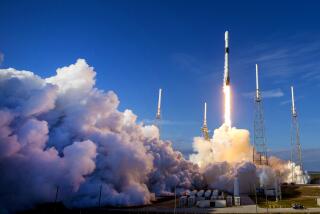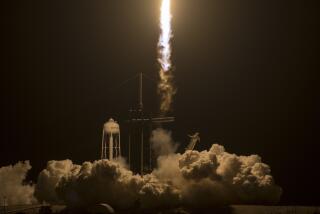Pilotless Aircraft Destroyed During Test Flight
- Share via
EDWARDS AIR FORCE BASE — A pilotless, $4.9-million airplane funded by NASA was blown apart at 19,000 feet on a test flight Tuesday when it suddenly went out of control, officials said, at least the third such loss in two years.
Fearing that the aircraft, dubbed Theseus, would veer out of the test area, ground-based operators destroyed it by remote control, according to John Langford, president of Aurora Flight Systems, which built the lightweight plane.
Earlier this year, a stealth spy aircraft called the DarkStar crashed into an Edwards’ runway on takeoff. The cost of the test aircraft was unavailable, but production models of DarkStar were predicted to cost $10 million apiece. Tuesday’s incident marked the second loss of an Aurora-built plane at Edwards. Aurora’s Perseus, which was smaller and cost about $1.5 million, broke apart during a sharp dive on a test flight in November 1994.
“Losses are expected in this kind of testing,” said Langford from company headquarters in Manassas, Va. “Of course, every loss is a setback, but we will be using the lessons we learn from this one in the development of a second [Theseus].”
If there is a second one.
The Theseus, designed to observe climatic conditions as part of the federal Mission Planet Earth project, was built under a $6-million NASA contract. Of that, $1.1 million went into research and development on the aircraft, which had a 140-foot wingspan and was constructed mostly of composite materials.
No funds have been appropriated for a second Theseus, but Langford believes they will be forthcoming. “The cost is relatively cheap,” said Langford. “The Germans built a manned aircraft for the same kind of research and that cost them $120 million before they abandoned the project.”
Langford said the Theseus was insured, but he declined to say for how much.
A NASA official at Edwards declined to comment on the future of the Theseus program.
“The cause is under investigation,” said Fred Brown, a spokesman for NASA’s Dryden Flight Research Center at Edwards, which provided facilities for the tests. “That’s the first thing we have to determine.”
In the earlier Perseus incident, investigators blamed a faulty gyroscope for its breakup in a dive.
Langford said pilotless aircraft can be built at relatively low cost because “you don’t have to take along all the things that protect and nurture the pilot. Pressurization, oxygen, safety systems--they all drive up the cost and the weight.”
The Theseus, named for a hero of Greek mythology, was designed to remain at altitudes up to 60,000 feet for long periods of time. Tuesday, it was on its sixth test flight and had reached a planned altitude of 20,000 feet--a record for the aircraft--on what had been a textbook flight.
“It was operating just as expected. There were no issues or concerns,” said Brown.
“It was on its way home when something happened,” said Langford, who was on the telephone to officials at the test site during the flight. “There was only a few seconds warning. I heard them say, ‘the wing is rocking, we have to terminate.’ ”
He said that a great deal of information about the flight was received before Theseus was destroyed. “We recovered a lot of data,” he said. “We should be able to determine what happened.”
More to Read
Sign up for Essential California
The most important California stories and recommendations in your inbox every morning.
You may occasionally receive promotional content from the Los Angeles Times.










